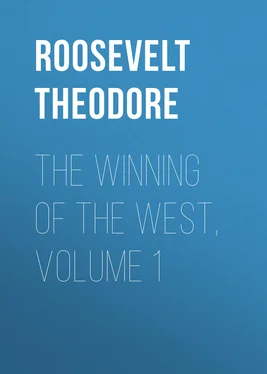Theodore Roosevelt - The Winning of the West, Volume 1
Здесь есть возможность читать онлайн «Theodore Roosevelt - The Winning of the West, Volume 1» — ознакомительный отрывок электронной книги совершенно бесплатно, а после прочтения отрывка купить полную версию. В некоторых случаях можно слушать аудио, скачать через торрент в формате fb2 и присутствует краткое содержание. Жанр: foreign_prose, История, foreign_edu, foreign_antique, на английском языке. Описание произведения, (предисловие) а так же отзывы посетителей доступны на портале библиотеки ЛибКат.
- Название:The Winning of the West, Volume 1
- Автор:
- Жанр:
- Год:неизвестен
- ISBN:нет данных
- Рейтинг книги:5 / 5. Голосов: 1
-
Избранное:Добавить в избранное
- Отзывы:
-
Ваша оценка:
- 100
- 1
- 2
- 3
- 4
- 5
The Winning of the West, Volume 1: краткое содержание, описание и аннотация
Предлагаем к чтению аннотацию, описание, краткое содержание или предисловие (зависит от того, что написал сам автор книги «The Winning of the West, Volume 1»). Если вы не нашли необходимую информацию о книге — напишите в комментариях, мы постараемся отыскать её.
The Winning of the West, Volume 1 — читать онлайн ознакомительный отрывок
Ниже представлен текст книги, разбитый по страницам. Система сохранения места последней прочитанной страницы, позволяет с удобством читать онлайн бесплатно книгу «The Winning of the West, Volume 1», без необходимости каждый раз заново искать на чём Вы остановились. Поставьте закладку, и сможете в любой момент перейти на страницу, на которой закончили чтение.
Интервал:
Закладка:
In summer they wore buckskin shirts and breech-clouts; in winter they were clad in the fur of the bear and wolf or of the shaggy buffalo. They had moccasins of elk or buffalo hide, and high thigh-boots of thin deer-skin, ornamented with fawns' trotters, or turkey spurs that tinkled as they walked. In their hair they braided eagle plumes, hawk wings, or the brilliant plumage of the tanager and redbird. Trousers or breeches of any sort they despised as marks of effeminacy.
Vermilion was their war emblem; white was only worn at the time of the Green-Corn Dance. In each town stood the war pole or painted post, a small peeled tree-trunk colored red. Some of their villages were called white or peace towns; others red or bloody towns. The white towns were sacred to peace; no blood could be spilt within their borders. They were towns of refuge, where not even an enemy taken in war could be slain; and a murderer who fled thither was safe from vengeance. The captives were tortured to death in the red towns, and it was in these that the chiefs and warriors gathered when they were planning or preparing for war.
They held great marriage-feasts; the dead were buried with the goods they had owned in their lifetime.
Every night all the people of a town gathered in the council-house to dance and sing and talk. Besides this, they held there on stated occasions the ceremonial dances; such were the dances of war and of triumph, when the warriors, painted red and black, returned, carrying the scalps of their slain foes on branches of evergreen pine, while they chanted the sonorous song of victory; and such was the Dance of the Serpent, the dance of lawless love, where the women and young girls were allowed to do whatsoever they listed.
Once a year, when the fruits ripened, they held the Green-Corn Dance, a religious festival that lasted eight days in the larger towns and four in the smaller. Then they fasted and feasted alternately. They drank out of conch-shells the Black Drink, a bitter beverage brewed from the crushed leaves of a small shrub. On the third day the high-priest or fire-maker, the man who sat in the white seat, clad in snowy tunic and moccasins, kindled the holy fire, fanning it into flames with the unsullied wing of a swan, and burning therein offerings of the first-fruits of the year. Dance followed dance. The beloved men and beloved women, the priest and priestesses, danced in three rings, singing the solemn song of which the words were never uttered at any other time; and at the end the warriors, in their wild war-gear, with white-plume headdresses, took part, and also the women and girls, decked in their best, with ear-rings and armlets, and terrapin shells filled with pebbles fastened to the outside of their legs. They kept time with foot and voice; the men in deep tones, with short accents, the women in a shrill falsetto; while the clay drums, with heads of taut deer-hide, were beaten, the whistles blown, and the gourds and calabashes rattled, until the air resounded with the deafening noise. 59 59 Hawkins and Adair, passim .
Though they sometimes burnt their prisoners or violated captive women, they generally were more merciful than the northern tribes. 60 60 Do . Also vide Bartram.
But their political and military systems could not compare with those of the Algonquins, still less with those of the Iroquois. Their confederacy was of the loosest kind. There was no central authority. Every town acted just as it pleased, making war or peace with the other towns, or with whites, Choctaws, or Cherokees. In each there was a nominal head for peace and war, the high chief and the head warrior; the former was supposed to be supreme, and was elected for life from some one powerful family—as, for instance, the families having for their totems the wind or the eagle. But these chiefs had little control, and could not do much more than influence or advise their subjects; they were dependent on the will of the majority. Each town was a little hotbed of party spirit; the inhabitants divided on almost every question. If the head-chief was for peace, but the war-chief nevertheless went on the war-path, there was no way of restraining him. It was said that never, in the memory of the oldest inhabitant, had half the nation "taken the war talk" at the same time. 61 61 Hawkins, 29, 70. Adair, 428.
As a consequence, war parties of Creeks were generally merely small bands of marauders, in search of scalps and plunder. In proportion to its numbers, the nation never, until 1813, undertook such formidable military enterprises as were undertaken by the Wyandots, Shawnees, and Delawares; and, though very formidable individual fighters, even in this respect it may be questioned if the Creeks equalled the prowess of their northern kinsmen.
Yet when the Revolutionary war broke out the Creeks were under a chieftain whose consummate craft and utterly selfish but cool and masterly diplomacy enabled them for a generation to hold their own better than any other native race against the restless Americans. This was the half-breed Alexander McGillivray, perhaps the most gifted man who was ever born on the soil of Alabama. 62 62 "History of Alabama," by Albert James Pickett, Charleston, 1851, II., 30. A valuable work.
His father was a Scotch trader, Lachlan McGillivray by name, who came when a boy to Charleston, then the head-quarters of the commerce carried on by the British with the southern Indians. On visiting the traders' quarter of the town, the young Scot was strongly attracted by the sight of the weather-beaten packers, with their gaudy, half-Indian finery, their hundreds of pack-horses, their curious pack-saddles, and their bales of merchandise. Taking service with them, he was soon helping to drive a pack-train along one of the narrow trails that crossed the lonely pine wilderness. To strong, coarse spirits, that were both shrewd and daring, and willing to balance the great risks incident to their mode of life against its great gains, the business was most alluring. Young Lachlan rose rapidly, and soon became one of the richest and most influential traders in the Creek country.
Like most traders, he married into the tribe, wooing and wedding, at the Hickory Ground, beside the Coosa River, a beautiful half-breed girl, Sehoy Marchand, whose father had been a French officer, and whose mother belonged to the powerful Creek family of the Wind. There were born to them two daughters and one son, Alexander. All the traders, though facing danger at every moment, from the fickle and jealous temper of the savages, wielded immense influence over them, and none more than the elder McGillivray, a far-sighted, unscrupulous Scotchman, who sided alternately with the French and English interests, as best suited his own policy and fortunes.
His son was felt by the Creeks to be one of themselves. He was born about 1746, at Little Tallasee, on the banks of the clear-flowing Coosa, where he lived till he was fourteen years old, playing, fishing, hunting, and bathing with the other Indian boys, and listening to the tales of the old chiefs and warriors. He was then taken to Charleston, where he was well educated, being taught Greek and Latin, as well as English history and literature. Tall, dark, slender, with commanding figure and immovable face, of cool, crafty temper, with great ambition and a keen intellect, he felt himself called to play no common part. He disliked trade, and at the first opportunity returned to his Indian home. He had neither the moral nor the physical gifts requisite for a warrior; but he was a consummate diplomat, a born leader, and perhaps the only man who could have used aright such a rope of sand as was the Creek confederacy.
The Creeks claimed him as of their own blood, and instinctively felt that he was their only possible ruler. He was forthwith chosen to be their head chief. From that time on he remained among them, at one or the other of his plantations, his largest and his real home being at Little Tallasee, where he lived in barbaric comfort, in a great roomy log-house with a stone chimney, surrounded by the cabins of his sixty negro slaves. He was supported by many able warriors, both of the half and the full blood. One of them is worthy of passing mention. This was a young French adventurer, Milfort, who in 1776 journeyed through the insurgent colonies and became an adopted son of the Creek nation. He first met McGillivray, then in his early manhood, at the town of Coweta, the great war-town on the Chattahoochee, where the half-breed chief, seated on a bear-skin in the council-house, surrounded by his wise men and warriors, was planning to give aid to the British. Afterwards he married one of McGillivray's sisters, whom he met at a great dance—a pretty girl, clad in a short silk petticoat, her chemise of fine linen clasped with silver, her ear-rings and bracelets of the same metal, and with bright-colored ribbons in her hair. 63 63 Milfort, 23, 326. Milfort's book is very interesting, but as the man himself was evidently a hopeless liar and braggart, it can only be trusted where it was not for his interest to tell a falsehood. His book was written after McGillivray's death, the object being to claim for himself the glory belonging to the half-breed chief. He insisted that he was the war-chief, the arm, and McGillivray merely the head, and boasts of his numerous successful war enterprises. But the fact is, that during this whole time the Creeks performed no important stroke in war; the successful resistance to American encroachments was due to the diplomacy of the son of Sehoy. Moreover, Milfort's accounts of his own war deeds are mainly sheer romancing. He appears simply to have been one of a score of war chiefs, and there were certainly a dozen other Creek chiefs, both half-breeds and natives, who were far more formidable to the frontier than he was; all their names were dreaded by the settlers, but his was hardly known.
Интервал:
Закладка:
Похожие книги на «The Winning of the West, Volume 1»
Представляем Вашему вниманию похожие книги на «The Winning of the West, Volume 1» списком для выбора. Мы отобрали схожую по названию и смыслу литературу в надежде предоставить читателям больше вариантов отыскать новые, интересные, ещё непрочитанные произведения.
Обсуждение, отзывы о книге «The Winning of the West, Volume 1» и просто собственные мнения читателей. Оставьте ваши комментарии, напишите, что Вы думаете о произведении, его смысле или главных героях. Укажите что конкретно понравилось, а что нет, и почему Вы так считаете.












